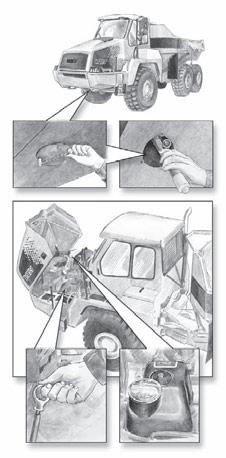
13 minute read
500 Hours Service
1
1. Engine
1.1. Change oil 1*
If the dump truck is used for particulary demanding operation, especially in a dusty environment or if the deposits in the centrifugal cleaner are thicker than 20 mm: Change oil more often.
1.Remove the cap on the drain plug, install the draining hose (tool kit) and drain the oil when the engine is hot.
Access through the drain hole in engine bottom guard (1). 2.When all oil is drained, remove the draining hose and reinstall the cap. 4.Reinstall the cover for drain hole in engine bottom guard. 5.Fill oil through filler (2). Do not overfill! 6.Check oil level on dip stick (3).
CAUTION
The oil may be hot! Wear protective gloves and eye protection.
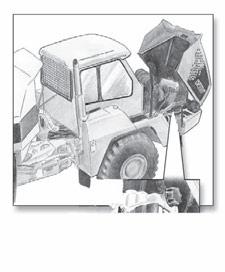
1.2. Clean centrifugal cleaner 2* (at the same time as oil change, item 1.1)
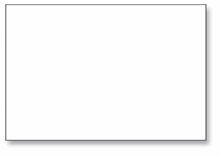
1.Clean the cover. Unscrew the nut and remove cover.
CAUTION
Open the cover with care. The oil and inner parts may be hot!
2. Lift out the rotor assembly and loosen the nut for the rotor cover three turns.

3. If the nut sticks:
Secure the nut, absolutely not the rotor, in a vice and turn the rotor three turns by hand or using a screwdriver.
4. Gently tap the nut with the hand or with a plastic hammer to separate the rotor from bottom plate.
5. Undo the nut and remove the rotor cover.
6. Carefully prise the strainer loose from the bottom plate.
7. Scrape off the deposits from the inside of rotor cover. • If there are no deposits, this shows that the cleaner is not working. • Clean more frequently if deposits are thicker than 20 mm.
8. Clean all parts in diesel fuel.

9. Place the O-ring in position in the rotor cover. • The O-ring must not be damaged. Change if necessary.
10.Assemble the rotor.
11.Tighten rotor nut firmly by hand.
12.Reinstall the rotor. • Check that it rotates easily.

13.Check that the O-ring in the cover is not damaged.
Hard or damaged O-ring must be replaced. 14.Tighten cover firmly by hand. 15.If the nut is tightened too hard (for instance by using tools), the cover, nut or rotor shaft may be damaged! 16.Replace damaged parts!
17.Function check
The rotor rotates very fast, and will normally carry on rotating after the engine is stopped. a. Stop the engine when it is warm. b. Listen for spinning sound from rotor, or feel if cleaner housing vibrates. c. The rotor normally rotates 30 - 60 seconds after the engine has stopped. d. If not, dismantle and check the cleaner.
m e
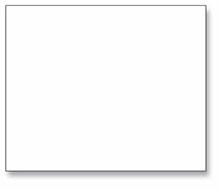
1.3. Replace oil filter 3* (at the same time as oil change, item 1.1)
1.The filter is located on the right hand side of the engine. 2.Remove the old filter and discard it according to enviromental requirements. 3.Oil the rubber gasket on the new genuine filter. 4.Fit the new genuine filter. 5.Tighten the filter by hand as tight as possible. 6.Start the engine and check for leaks. If the deposits in the centrifugal cleaner exceed 20 mm, the oil filter must be changed more often, at the same time as cleaning the centrifugal filter and changing the oil.
NOTE
• Never use tools to tighten the filter. It can be damaged and the circulation obstructed! • Use only genuine filter!
10 - 15 mm
1.4. Check batteries 11*

• Checking of batteries shall also be carried out after the first 8 hours of operation. 1.Open left hand side fender cover (open the bonnet first and then the fender cover) 2.Undo the plugs and check electrolyte level in all cells. 3.The fluid level in each cell shall be between 10-15 mm above the plates. 4.Refill with distilled water if level is lower.
NOTE
Only distilled or chemically cleaned water must be used.
1.5. Check battery terminals for tightness and corrosion
Clean if necessary, apply acid-free vaseline on the terminals and retighten the clamps.
2. Transmission
2.1. Run the AEB-Tester
AEB = Automatic Filling Parameter Adjustment
To optimize the transmission, run the AEB-Tester. 1.Remove the cover on the backwall (remove the instructor's seat back rest, if that is fitted). 2.Follow the procedure described in the table on next page. The gear display will show the AEB's actions. ("Display message" in the table on the next page).
TCU = Transmission Control Unit
Run the AEB-Tester continued..............
AEB = Automatic Filling Parameter Adjustment TCU = Transmission Control Unit

How to run the AEB-Tester Display message
1 Warm up the transmission oil, the oil must have a temperature at 70 - 80OC Normal operating messages
2 - Move the gear selector to Neutral position. - Engage the parking brake 3 Turn OFF the starter switch 4 Plug the AEB-Tester into the diagnostic contact no. 607 5 Start the engine "PL"
6 Set engine speed to low idle rpm "PL" if starts condidtions are OK
Remarks
TCU must recognize "PL" for at least 2 sec. before you can press the button.
7 Press button on the AEB Tester "ST" if starts conditions are OK The button must not be released before TCU has started the AEB or quit with an error code.
8 Keep the button depressed until the AEB has started "K1" …… (Information about the AEB state)
9 Wait until AEB is finished "OK" (AEB has been successful)
10 Turn OFF the starter switch and unplug the AEB-Tester 11 Remount the cover on the backwall TCU has started the AEB and goes to adjusting K1, K2, …, KR. (Button may be released).
NOTE
• If the oil temperature is too low or too high, following message will apear on the gear display:
T or T . Adjust the oil temperature and try again. • If there is a malfunction, turn the starter switch off and start the engine again. • The AEB will not start if any error codes are shown on the gear display, except error code "F6"
3. Drive line
3.1. Check oil levels
• Measurements must be carried out when dump truck is parked on a horizontal ground. • Check that oil level is near the bottom edge of the plugs. • Refill with oil if level is too low. • If the dump truck tandem housing is angled, the reading will be incorrect.
CAUTION
Be aware of possible internal pressure when the oil is hot!
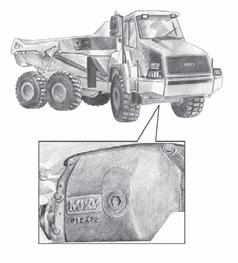
1. Front differential 30*
Use a hexagonal key to unscrew the upper filling/ level plug. •Plug torque: 80 Nm
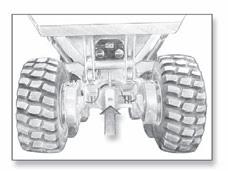
2. Rear differential 31*
Use a hexagonal key to unscrew the filling/level plug at the rear of housing. • Plug torque: 80 Nm.
3. Tandem housings 32*
Use a hexagonal key to unscrew the level plugs on the inside of the housings. • Plug torque: 80 Nm.
4. Front reduction gears 33*
Turn the hubs until level indicator is horizontal. Use a hexagonal key to unscrew the plugs. • Plug torque: 80 Nm.
Service brake
Parking brake
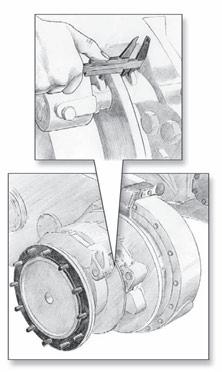
4. Brake system
4.1. Check lining thickness
• Checking of brake lining thickness shall also be carried out after the first 500 hours of operation. 1. Service brakes: Check brake linings. Brake linings should be changed before the thickness of the linings on the most worn areas reaches 3,5 mm.
• How often the brake linings have to be checked/replaced depends on how much the brakes are used and/or applications. After checking the brake linings for the first 500 hours, consider whether or not the brake linings should be checked more often, based on lining wear. 2. Parking brake:
Lift body and apply the body support.
Remove the protection on the top of the parking brake and check thickness of linings. Change when approaching limit.
• In connection with replacement perform adjustment, see next page.
Standard lining thickness:Service brakes: 22.0 mm Parking brake: 20.0 mm Min. thickness: Service brakes: 3.5 mm. Parking brake: 5.1 mm.
CAUTION
This applies to normal driving. For rough operating conditions with much braking and/or driving in water, the brake linings should be checked more often!
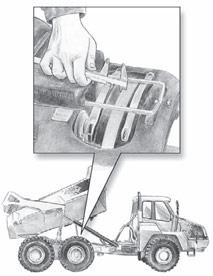
1
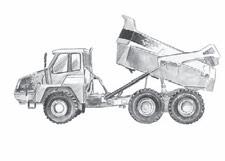
Washer-adjuster plug Adjuster plug Maintenance to be performed every 500 hours of operation.
Allen wrench
4.2. How to adjust the parking brake.
To be performed in connection with replacement of parking brake linings.
• Before removing the parking brake linings, do as follows:
1.Apply the parking brake. 2.Lift the body. 3.Apply the body support (1) (see also safety instructions, chapter 2). 4.Stop the engine. 5.Secure the dump truck with wheel chocks (see also safety instructions, chapter 2) 6.Release the parking brake by the parking brake switch. 7.Remove the adjuster plug and washer from the cylinder bracket.
8.Use a 6 mm allen wrench to de-adjust the brake (turning the allen wrench in clockwise direction). Stop turning the allen wrench when you feel resistance, which indicates that the adjuster pistons are fully retracted. •When you de-adjust the brake (increase disc clearance) you will hear a "clicking" sound and feel a "pulsing" sensation during the adjustment. •To ensure that the automatic adjustment will occur:
Adjust the brake an additional 1/4 turn after you reach the resistance point. •Do not use an air gun to adjust or de-adjust the parking brake! Components could be damaged. 9.The parking brake linings can now be replaced.
• After installation of new parking brake linings, do as follows:
1.Adjust the caliper by reducing the caliper-to-disc clearance to ZERO (turning the allen wrench in counter clockwise direction). 2.Check that the load plate fully contacts the lining backing plate. 3.To increase the disc clearance, turn the allen wrench
SEVEN CLICKS in clockwise direction, which sets the initial clearance.
4.Install the adjuster plug and washer. •Tightening torque: 11-17 Nm 5.Apply and release the parking brake 15-20 times to allow the adjuster to set the final caliper clearance.
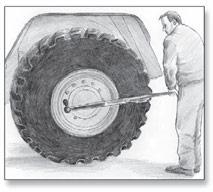
5. Wheels
5.1 Check wheel nuts torque.
Torque setting 450 Nm.
6. Tip- and steering cylinders
6.1 Check expander bolts.
• Checking of the expander bolts torque setting shall also be carried out after the first 100 hours of operation. Torque setting: •Tip cylinder bolt: 250 Nm •Steering cylinder bolt: 380 Nm •The torque must be checked on on both sides of the bolts. •Be aware of the lubrication nipples on the bolts when checking the torque.
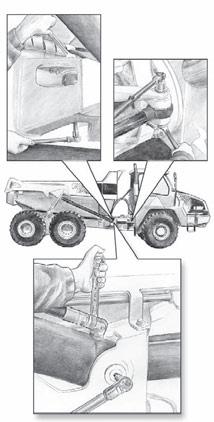
2

7. Cab ventilation
7.1. Air conditioner system, test operation
1.Start the engine. 2.Press down the air conditioner switch, set the fan switch to position 3 (see also chapter 3) and open all nozzles. 3.Check that the temperature in the cab decreases. •If the temperature does not decrease: • Check whether the fuse is burnt out, if yes, replace the fuse. • If the fuse is not burnt out, there can be a failure or too little refrigerant in the system: CONTACT YOUR LOCAL MOXY DEALER
WARNING
• If the air conditioning system does not work properly, contact your Moxy Dealer.
• Always use safety glasses or goggles, gloves, boiler suit and protective footwear when inspecting, servicing and repairing the air conditioning system.
• Refrigerant R134a has a property that can cause frostbite if it comes into contact with bare skin or eyes.
• Always work on the air conditioning system in well ventilated places.
• The system contains refrigerant R134a under pressure. Repair and refilling of the refrigerant circuit must only be done by accredited personnel.
• Dispose of waste oil/fluids in an enviromentally friendly manner!
• High concentration of the refrigerant in gaseous form can cause drowsiness, headache, dizziness and at worst unconciousness. Very high concentration of the gas can even cause cardiac insufficiency.
Do not smoke when servicing the air conditioning system!
• Be careful with all hoses connected to the air conditioning system. There is always a certain overpressure in the system. Therefore, never undo hoses or the filler opening on the compressor except during repairs to the system.
• If there is any suspicion of leakage, the system must not be filled up - leave the leakage site and contact your Moxy Dealer for repairs.
• Get your Moxy Dealer to check the air conditioning system yearly and refill refrigerant, if necessary.
• See also chapter 2, Safety Instructions
7.2. Check cab ventilation filter element condition 70*
1.Remove the rear panel on the right hand side inside the cab (behind the driver's seat). 2.Open the cover (1) with a screw driver. 3.There is two filter elements (2). 4.Check if the filter elements are clogged or damaged. •Replace if necessary. 5.Reassamble the opposite way. 6.Adjust the check interval if another requirement is experienced.
2
Located under the cover
8. Automatic central lubrication
8.1. Refill the reservoir, the reservoir must be refilled if the indicator light flashes for 2 minutes (0.5s on/0.5s off) at the beginning of each cycle.
1.Remove the dust cap from the filler coupling. 2.Carefully clean the filler coupling and the coupling on the filler hose.
3.Fit the filler hose on the filler coupling. 4.Fill the reservoir up to the maximum level indicated on the reservoir.
5.Remove the filler hose and fit the dust cap.
8.2. Check the system
• Check the pump for damage and leakage. • Check the grease lines for damage and leakage. • Check, if possible, the condition of the grease points the system serves. Sufficient fresh grease should be present. • Check the operation of the system. Perform a cycle test (see chapter 3 for how to perform a cycle test). Note that every time you perform a cycle test, grease is supplied to the grease points. • Clean the pump-unit and its surroundings.






